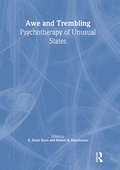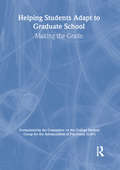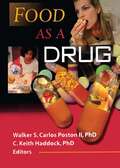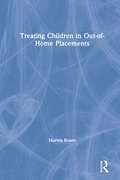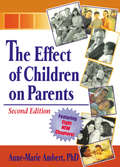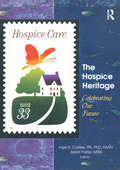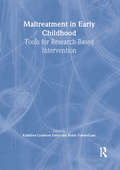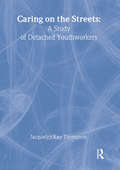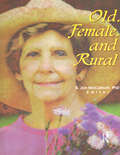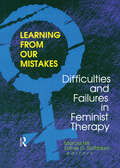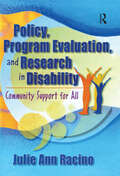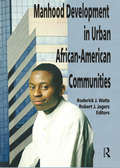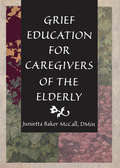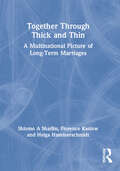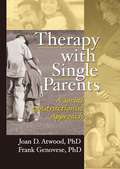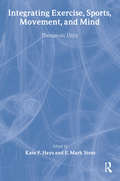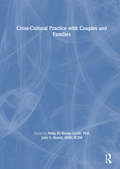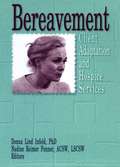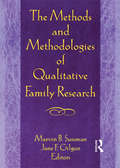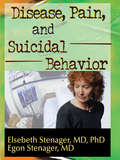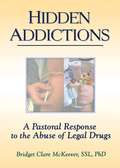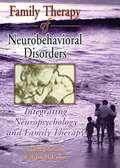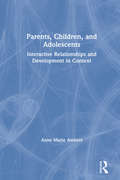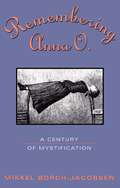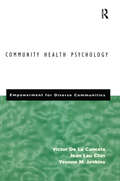- Table View
- List View
Awe and Trembling: Psychotherapy of Unusual States
by E Mark Stern Robert B MarchesaniGain new insight into panic and anxiety-related disorders!Awe and Trembling: Psychotherapy of Unusual States provides psychologists, psychotherapists, and clinical social workers with an overview of the symptoms and causes of panic. The book gives insight into how patients cope with anxiety to help you provide more sympathetic services to your clients. You will discover how to deal with panic in an integrative way rather than relying on medication or cognitively coping by rationalization. You will also discover current methods that will improve the lives of suicidal patients, such as talking the patient through the suicidal act and inspiring thought about what would happen and discussing what the patient intends for those that are left behind. Awe and Trembling offers effective techniques that will help you give better care to clients suffering from these difficult disorders.Compelling and informative, Awe and Trembling will help you recognize when panic in your patients is a breakthrough rather than an impending breakdown or collapse. You'll be able to help your patients find new possibilities for a better life, instead of living with the chaos that comes with anxiety.In Awe and Trembling, you'll find ideas that will help you assist your patients in overcoming anxiety and panic, such as: discovering ways to treat each patient as a living, breathing individual with his or her own personality and treatment needs examining the therapy session as a vehicle for meditative awakening and deeper self-understanding for your patients realizing that if you replace the isolation of panic with structure and connection using such techniques as breathing exercises or yoga, panic attacks can be controlled acknowledging that suffering has potentially liberating as well as debilitating dimensions discovering an integrated clinical model of understanding that addresses panic and anxiety from an existential perspective understanding that anxiety and panic often serve as opportunities for clients to examine the conflicts in their lives and within themselves to create a deeper, more authentic existenceAwe and Trembling will show you new ways to help your clients on their journey toward wholeness and a more comfortable, rewarding life. This valuable book will provide you with a unique perspective on panic and awe to help your clients overcome their anxieties and heal themselves and their lives so they can regain their emotional and physical independence.
Helping Students Adapt to Graduate School: Making the Grade
by Chairperson Robert L. Arnstein, Md Varda Backus, Md, Chairperson Robert L. Arnste SilberHelp graduate students cope with the pressures of school, finances, family, and professors! In order to succeed in school: The college undergraduate just has to be able to find and operate an elevator in the campus high-rise The master's degree student has to climb the side of the building The PhD student doing research with a professor has to jump over the building in a single bound, carrying the professor That bit of grim humor contains a bitter kernel of truth. Helping Students Adapt to Graduate School is the first book that focuses on the unique problems of graduate students and the best ways to counsel and support them. Graduate and professional schools are draining - emotionally, financially, and physically. In addition to coping with the pressures of classes and high performance expectations, many graduate students juggle multiple lives, trying to please their professors, maintain their status as adults, pay for books and classes and rent and food, keep up a place to live, preserve their marriages, raise their children, and deal with their parents, all while they work as teaching assistants, resident advisors, or research assistants. When adults return to school, they may find themselves forced into a childlike status, causing considerable resentment or regression and sometimes reawakening old conflicts. Furthermore, the relationship of professors and graduate students is often complex and emotionally enmeshed, tinged with issues of respect, rivalry, and even romance. Not surprisingly, many graduate students find the conflicts overwhelming at times. With fascinating case studies and lucid explanations, Helping Students Adapt to Graduate School offers a clear look at the special difficulties of graduate students and practical ways the university can help, including: fostering a sense of belonging providing year-round mental health services helping students handle financial pressures and career decisions supporting the unique needs of minority, international, married, and older students understanding the hidden subtext of faculty-student relationships encouraging a balance of family and school Helping Students Adapt to Graduate School is an essential resource for deans, administrators, professors, and counselors working with graduate students. By illuminating the complex interplay between the university environment and the inner psychological life of graduate students, it will help you provide supportive services to the students in your campus community.
Food as a Drug
by Walker S Poston C Keith HaddockFood as a Drug provides psychologists, psychiatrists, and counselors with a unique discussion about possible addictive qualities of some foods to assist clients who are struggling with obesity or eating disorders. Examining the pros and cons of treating eating disorders with an addictions model, this book also explores the tremendous societal and personal costs of eating disorders and obesity, such as increased risk of heart disease, health care costs, and death. Thorough and concise, Food as a Drug will assist you in providing better services to clients with these types of dilemmas.Comprehensive and current, this reference provides information on relevant topics, such as diet and behavior relationships; cross-cultural perspectives on the use of foods for medicinal purposes; regulatory perspectives on drugs, foods, and nutritional supplements; and whether foods have pharmacological properties. Food as a Drug address several important topics, such as: focusing on sugar to determine the effects of food additives on children's behavioral disorders, such as attention deficit disorder and hyperactivity addressing the role that your diet plays on serotonin levels, carbohydrate craving, and depression examining the phenomenological, psychological, and physiological correlations between overeating and how foods may be used to alleviate negative moods discussing the pros and cons of treating obesity and eating disorders with addiction modelsWritten by experts in the field, this book offers you in-depth studies and information about the nature of food as a potentially addictive substance. Food as a Drug will help you understand these difficult-to-treat conditions and offer clients better and more effective services.
Treating Children in Out-of-Home Placements
by Marvin RosenIf you’re in the market for a detailed, pragmatic knowledge base for dealing with discipline, relationships with regulatory and funding agencies, and staff training, you’ll find all you need and more in Treating Children in Out-of-Home Placements. This unique and insightful volume gives you the information you need to successfully manage quality assessment and improvement in out-of-home placements, especially in a managed care environment.Treating Children in Out-of-Home Placements reviews for you the field of residential treatment of adolescents in the child welfare system. With this crucial knowledge base, you’ll be equipped to face and surmount the challenges that accompany the provision of services to behaviorally disturbed youngsters. Some of the areas you’ll become fluent in are: approaches to child welfare for children at risk models of treatment family counseling diagnostic criteria for conduct and behavior disorders psychotropic medication training staff to become agents of changeFor over 150 years, we’ve seen the aftershocks of a problematic system for treating children placed in the custody of child welfare. Through treating Children in Out-of-Home Placements, you can understand the problems of implementing and administering such a program. You will want to open this book and place yourself and your staff members on the road to a more ideal plan of care for children placed in custody.
The Effect of Children on Parents
by Anne Marie AmbertRecognize the hidden costs and rewards of childrearing!The Effect of Children on Parents, Second Edition, thoughtfully explores the interactions by which parents and children change, develop, and sometimes affect each other negatively. Everyone knows that parents influence their children, but few people consider the ways in which children affect their parents. The love, satisfaction, and fulfillment children offer can change parents’lives. So can the stress, worry, and financial drain. The Effect of Children on Parents, Second Edition, honestly confronts these long-neglected issues of family dynamics. Taking a unique interdisciplinary approach, this book describes in great detail, with jargon-free language the various aspects of children's effects on their parents. This second edition contains an abundance of fresh information, including nine entirely new chapters that deal with such complex topics as the effects on parents of children with emotional, behavioral, and delinquency problems. The Effect of Children on Parents, Second Edition, asks and answers essential questions on the parent-child dynamic, including: what role does genetic inheritance play in children's responses to their parents? how do peers influence children and through them, their parents? what happens to parents when children are difficult or have emotional problems? what special considerations apply to minority or adoptive parents? how do adult childrem affect their aging parents? how does society support or undermine parents? what roadblocks prevent parents from being as effective as they would like to be?The Effect of Children on Parents, Second Edition, takes a brave look at this often ignored area of family dynamics, giving a richer, more complex, and ultimately more healing view of how humans interact in families. Professors, students, and experts in the fields of child development, family studies, and sociology of childhood and family will find this book a sophisticated tool in their desire to better understand and help families and children.
The Hospice Heritage: Celebrating Our Future
by Inge B. Corless Zelda FosterThrough The Hospice Heritage: Celebrating Our Future, physicians, nurses, social workers, and clergy will find unique examples to give patients the attention, care, and understanding they need at that time in their life. Since 80 of people who die do so without the support of a hospice program, this important book offers approaches designed to expand access to hospice and provide a solid foundation of treatment for patients with cancer and non-cancer diagnoses. Written by experts in the field, The Hospice Heritage will help you care for those patients whose life span is uncertain, improving their quality of life in throughout their last days. This commemorative book offers an encompassing portrayal of the development of hospice from its origins to its present forms. The Hospice Heritage contains state-of-the-art presentations of hospice-related issues and examines current efforts in hospice and palliative care, including the latest concepts in symptom control, guidelines for patients with diseases other than cancer, and measuring the quality and impact of care. Informative and moving, The Hospice Heritage explores the physical, psychological, social, and spiritual aspects of end-of-life care. This important book discusses many topics relevant to hospice today, including: presenting the most common physical symptoms experienced by hospice patients and the comprehensive standards of care for these symptoms; deepening the spiritual aspect of dying as patients, families, and care providers seek understanding and resolution; examining end-of-life decision-making issues, and the barriers which continue to restrict patient and family involvement and choices and identifying the evolving relationship between hospice and palliative care and the consequences, benefits, and dilemmas of this partnership.
Maltreatment in Early Childhood: Tools for Research-Based Intervention
by Robin Vanderlaan Kathleen Coulborn FallerDetect and put a stop to child abuse!For mental health professionals, social workers, legal professionals, and policy makers, Maltreatment in Early Childhood: Tools for Research-Based Intervention examines strategies and ideas for professional training in child protection in the United States. Derived from presentations at the San Diego Conference Responding to Child Maltreatment, this book addresses current assessment issues, the intersection of child maltreatment and other social problems, the history of child protection, and the intricacies of courtroom testimonies, and provides guidance for case management. Through insight into research and case studies, Maltreatment in Early Childhood explores effective approaches to child-friendly services, multivictim cases, therapy, and victim recantation to help you assist sexually abused children or children who have witnessed domestic abuse.Addressing a variety of challenges that face all those involved with youth in need of assistance due to abuse, this informative book examines why children of different racial identities may display different secret-keeping behavior, and presents a variety of approaches that encourage clients to talk about their situation. Maltreatment in Early Childhood explores child abuse from a historical and political context, and discusses key issues relating to all facets of this social problem, including: understanding the pros and cons of asking children to recall their experiences through specific types of questions, such as invitational questions and less preferred questions, which may or may not reveal true answers deciding if the Validity Checklist, the second part of the Analysis procedure, is able to determine truthfulness of allegations in child sexual abuse cases testing the efficacy of the model designed at the National Children's Advocacy Center (NCAC), which may be used to validate abuse and determine if children's statements are accurate overcoming difficulties in the child protection system, including the probability of multiple interviews and potential contamination of children's narratives by a variety of sources, to produce fair evaluations and successful prosecutionsWith tables and charts that will help you easily explore research findings, Maltreatment in Early Childhood provides you with the information you need in order to determine the truth of children's statements, how to present statements in court, and how to affect changes that will protect and assist victims of childhood sexual abuse.
Caring on the Streets: A Study of Detached Youthworkers
by Jacqueline K ThompsonThey're fighting for our kids, and the battleground is the street!In 1956, the Boston Special Youth Project defined the field of detached youthwork this way: “Detached work involves intensive contact with a corner-group where the worker meets the teen-age group in their natural environment. By close association with them and getting to know their needs as a group and as individuals, the worker forms a positive relationship and helps them to engage in socially acceptable activities which they come to choose. The basic goal is helping them to change undesirable attitudes and patterns of behavior.”Today, author and youthworker Jacquelyn Kay Thompson brings this exciting, heartbreaking and often dangerous profession to light in Caring on the Streets: A Study of Detached Youthworkers. The book examines the demanding task of assisting runaways, gang members, prostitutes, drug addicts, and other troubled youths and explores how the profession is practiced in the United States. Here are true-life stories of the courageous, caring individuals whose professional life is spent on the streets, in bars, pool halls, motels, housing projects, and hangouts “where the kids are.” In addition to sharing the personal experience of detached workers, Caring on the Streets illuminates these facets of the profession: history of detached youthwork methodology and philosophy of detached youthwork model programs research procedures for youthworkers becoming a detached youthworker ...and more!Caring on the Streets contains interviews with seventeen youthworkers who assist clients outside of formal office settings to give you insight into the experiences, challenges, and dedication of detached youthworkers. This thoughtfully-indexed work also includes reference notes and five appendixes.
Old, Female, and Rural
by B Jan MccullochIn reading Old, Female, and Rural, you’ll discover just that--the reality concerning the daily living situations of the nation’s older female populations in rural places. This scholarly collection will help you and others dispel the romantic frontier myths of the stoic, tenacious, and independent rural woman. Instead, you’ll find real direction for change in the statistics that truly reflect the older rural woman’s mental, physical, economical, and social existence.Old, Female, and Rural will show you stark realities concerning the older rural female’s economic well-being, intergenerational family relationships, health care and service delivery availability, and long-term care concerns. The candid demographic and epidemiological data you discover in this book will not only expose the myths for what they are, but also allow you and others to transform the myths into daily realities of better policies and better living standards for the women who belong to this population subgroup. Specifically, you’ll read about: one woman’s subjective evaluation of growing old in a rural area rural women’s experiences of accessing health care the economic well-being of women aging in nonmetro areas changes in the informal support networks of women aging in the rural southwest a comprehensive synthesis of the above isolated topics, which provides future implications for research, education, and policyWhile the legends of the old American frontier have died, the older female populations in America’s rural areas live on--and they deal with some very challenging realities. Old, Female, and Rural takes you into the homes, lives, and minds of this complex and unique subgroup of America’s elders and points you and public administrators, government officials, educators, and civil servants toward the unsettled frontier of real social change.
Learning from Our Mistakes: Difficulties and Failures in Feminist Therapy
by Esther D Rothblum Marcia HillIf you’re a long-time veteran of feminist therapy or someone just starting out, you’ll find a helpful, reliable list of “dos” and “don’ts” in Learning from Our Mistakes: Difficulties and Failures in Feminist Therapy. Frank and honest in tone, makeup, and style, this one-of-a-kind publication looks at the failures and roadblocks that have hampered feminist therapists in the past so you can learn from their misfortunes and avoid them in your own professional endeavors. In Learning from Our Mistakes, you’ll come face-to-face with classic difficult cases, and you’ll see from a feminist perspective how therapists used various treatments to deal with these seemingly insurmountable challenges. You’ll find that these and other topics will help you in navigating the difficult situations that arise in your personal practice: the pros and cons of terminating with a client who has an eroticized transference differences between therapists and clients in terms of race, ethnicity, and age problems encountered by rural therapists in small communities using a translator in therapy when the therapist and client don’t speak the same language feelings of anger in therapy many other “log jams” in the therapeutic processIt’s no mistake that Learning from Our Mistakes is full of what works and what doesn’t. In it, three veteran discussants give you the tools necessary to overcome the uncertainties and inadequacies that plague therapists. You’ll come away understanding the many ways failure is embedded in both the theory and practice of psychotherapy. Ultimately, you’ll find that mistakes are really only failure narratives waiting to be used, shaped, and turned toward the positive experiences of both client and therapist.
Policy, Program Evaluation, and Research in Disability: Community Support for All
by Julie Ann RacinoExplore case studies from the 1980s and 1990s that highlight the progress of community programs for people with disabilities! Policy, Program Evaluation, and Research in Disability: Community Support for All is an essential research reference on how community support systems can greatly assist people with diverse disabilities to live fuller lives outside of institutions. Based on qualitative research methods, Policy, Program Evaluation, and Research in Disability reflects over a decade of technical assistance and research in state, regional, and local communities throughout the United States. Community service managers, policy makers, researchers, activists, individuals with disabilities, and their families will benefit from the numerous studies that promote a better quality of life for those living with disabilities. Structured around the support and empowerment paradigm, which strives to enhance the independence of people with disabilities, Policy, Program Evaluation, and Research in Disability offers studies that combine in-depth, qualitative research approaches for use with field practicums, research internships, and professional development. You will examine studies that cover several different types of community support systems, in the fields of mental health, mental retardation, brain injury, physical and multiple disabilities.In Policy, Program Evaluation, and Research in Disability, some of the topics you will read about include:public policies to support changes in communities and governmental programs advocating for statewide changes in housing andcommunity support programs national, regional, and local studies of organizations and innovations supporting people with disabilities working for the inclusion of individuals with disabilities in public schools and communities agencies as supporters and funders of personal choice, self-advocacy, and services to families case studies on community integration that show people with disabilities living successful lives personal assistance services as described by leading consumer experts and advocates maximizing the personal futures of people with disabilities through supported employment, housing and community living With Policy, Program Evaluation, and Research in Disability, you will gain an in-depth look at the programs and policies available to people with disabilities and the emerging trends, directions, and recommendations for these programs. An excellent guide and research tool, this book challenges you to reach to another level of advocacy and not to settle for the status quo when it comes to bringing interdependence to everyone.
Manhood Development in Urban African-American Communities
by Robert J Jagers Roderick J WattsOne of the first books to unite practice, research, and theory in addressing manhood development, Manhood Development in Urban African-American Communities aids in the construction of more holistic and progressive notions of African-American manhood. Proceeding from a psychological perspective, this text explores issues of culture and race as they impact on the cognitive, emotional, and behavioral characteristics of African-American boys and men. You will see how the development of self-esteem and self-image in African-American men are specifically affected by issues of gender, race, culture, religion, and oppression. You will see how the development of self-esteem and self-image in African-American men are specifically affected by issues of gender, race, culture, religion. The understanding of culture, oppression, and gender you’ll gain from this book will enable you to promote the positive development of young men.Manhood Development in Urban African-American Communities covers theories, research, and intervention programs aimed at better understanding and addressing the challenges young African-American men face in urban areas. Psychologists, sociologists, social workers, and all others interested in research on youth development will be captivated by the books explorations of: the role of culture in the social development of African-American youth cluster profiles of racial socialization beliefs, giving special consideration to factors of spiritual/religious coping, extended family care, cultural pride reinforcement, and racial awareness oppression and sociopolitical development as a basis for interventions aimed at sociopolitical awareness and action findings from SQAKs (Student Questionnaire on Academic Performance, Cognitive Development, and Social Knowledge) completed by 100 participants of the RAAMUS (Responsible African-American Men United in Spirit) Academy and their implications for future youth interventions a multi-method study that explores the relationship between gender, spirituality, and spiritual well-being and several indices of religiosity, including religious participation and religious motivation a review of manhood and womanhood development in traditional African societies and the connection with contemporary developmentThe themes of gender, oppression-liberation, and culture found throughout Manhood Development in Urban African-American Communities provide a broad scope for the inclusion of a wide range of perspectives and disciplines, ranging from the psychological to the political. This broad perspective will bring to light the specific ways in which we need to change things to allow our young African-American men living in urban areas to form healthy, positive images of themselves as individuals and as part of a greater society in which they often face grave challenges.
Grief Education for Caregivers of the Elderly
by Harold G Koenig Junietta B MccallThrough firsthand accounts and research, Grief Education for Caregivers of the Elderly focuses on the education, training, and support of individuals who care for the elderly. This book provides caregivers with methods to cope with grief and loss and will help educators design programs that meet the needs of their consumers: the elderly and their families, friends, and service providers. From Grief Education for Caregivers of the Elderly, you'll learn how to cope with the stress and emotions of caregiving and improve the quality of services to your patients. With an emphasis on caregivers of the institutionalized elderly and the special services provided by clergy, chaplains, and pastoral counselors, Grief Education for Caregivers of the Elderly offers the caregiver or educator several model workshops focusing on grief, loss, and bereavement care. Grief Education for Caregivers of the Elderly contains proven methods and strategies that will sharpen and enhance your caregiving skills, including: focusing on the emotional responses and phases of dying, including denial, anger, and acceptance, to help patients deal with death considering physical and administrative atmosphere and your elderly population when setting goals and designing workshops to provide optimal patient/resident care discussing the themes of grief and loss, stress management, handling change, and promoting self-care for caregivers in workshops and through self-evaluations developing workshops that open with grief history surveys and attitude checklists, discuss normative development and issues of old age, and have themes based on the biological, psychosocial, and spiritual needs of the elderly person providing caregivers with an opportunity to practice what they have learned through case studies, simulated role play, open discussions, and care plan designing thinking about your own mortality and learning about your feelings and ideas of growing oldUtilized at a psychiatric nursing home facility of New Hampshire Hospital, the workshop exercises in Grief Education for Caregivers of the Elderly have allowed caregivers to express personal feelings; talk about beliefs and experiences; learn about biological, psychosocial, and spiritual processes of grief and phases of bereavement; and apply these understandings and insights into typical caregiving situations. Grief Education for the Caregivers of the Elderly gives you the framework for such a program, using vignettes, composite case material, poetry, and a holistic approach to health care to emphasize the importance of your emotional health and enhanced care of the elderly.
Together Through Thick and Thin: A Multinational Picture of Long-Term Marriages
by Florence Kaslow Shlomo A SharlinDiscover what factors, beliefs, and attitudes build a successful marriage!In the enormous social, political, and technological upheavals since World War I, the long and happy marriage has begun to seem like an endangered species. In the desperate hunt for reasons that marriages fail, most researchers have ignored the factors that help marriages succeed. Together Through Thick and Thin: A Multinational Picture of Long-Term Marriage reports a landmark study of long-term satisfaction in marriage. Instead of relying on conjecture or unproven clinical hunches, the authors studied the happily married around the world. The respondents’early experiences included the Great Depression, World War II, and the Holocaust as well as the Roaring Twenties. In the years since they married, technological change and the women's movement have made the world almost unrecognizable. Yet these people have managed to maintain both stability and quality in their marriages. The scope of Together Through Thick and Thin is sweeping: eight countries, more than 400 couples who had been happily married for between 25 and 45 years. Factors analyzed include degree of satisfaction, gender differences, socioeconomic level, family history, shared values, religious belief and practice, attitudes toward children, physical health, and problem-solving styles, among many others. Moreover, the book builds on existing documented literature on marriage. This solid background helps put its wealth of practical data into context, an ideal synthesis of theory and practice.This study delves into the reasons couples stay together and stay satisfied. What qualities and attitudes do happily married couples share? Can the factors that keep a Chilean couple together for life also apply in the very different cultures of Sweden, Israel, South Africa, the United States? What keeps a marriage together in times of crisis? How important is love?Together Through Thick and Thin helps you understand the diverse factors that affect marital quality and stability by offering a broad range of information:a comprehensive review of the literature of happy marriage cross-cultural comparisons that kindle fresh insights discussions of factors ranging from gender and economic status to family history and shared attitudes specific behaviors and attitudes that illuminate what matters most in marriage, from mutual respect to shared fun the reasons couples stick together during crises which problem-solving behaviors actually workTogether Through Thick and Thin provides psychologists, family therapists, and couples counselors with the solid data they need to guide couples in crisis toward greater intimacy, commitment, and joy together.
Therapy with Single Parents: A Social Constructionist Approach
by Joan D Atwood Frank GenoveseProvide effective counseling to members of single-parent familiesWith more than half of all first marriages ending in divorce, it&’s time to re-think the notion that "divorce" means "failure." Therapy with Single Parents focuses on the strengths of the single-parent family rather than its weaknesses, stressing the need to look at the socially constructed norms, values, and definitions associated with marriage and family in order to provide effective counseling. This unique book examines experiences that are common to single parents and presents interventive strategies for treating single-parent family issues, drawing on clinical case studies to provide technical knowledge in everyday language.Current research shows that single parents account for 27 percent of family households that include children under 18 and that the number of single mothers in the United States more than tripled between 1970 and 2000. Therapy with Single Parents challenges outdated notions that the single-parent family is somehow deficient and associated with adjustment problems in children. It doesn&’t ignore the anger, pain, sadness, and guilt experienced by many members of single parent families but offers therapeutic considerations from a more balanced approach. The book examines the social, psychological, and sexual experiences of newly single parents and addresses the ups and downs they&’ll face in dealing with schools, the workplace, and social services. Therapy with Single Parents examines: social and psychological differences between divorce and widowhood cognitive-behavioral principles of single-parent families what children can learn from divorce dealing with the ghosts of past relationships relationship rules dealing with adult children and extended families the effect of change in divorcing families the feminization of poverty the therapeutic value of social networksTherapy with Single Parents is an invaluable resource for psychologists, professional counselors, social workers, and marriage and family therapists. The book presents a thorough, in-depth examination of the single-parent family system as a viable, healthy family form.
Integrating Exercise, Sports, Movement, and Mind: Therapeutic Unity
by Kate F HaysRead Integrating Exercise, Sports, Movement, and Mind: Therapeutic Unity, and you’ll see how exercise and movement are actually the keys to achieving a harmonious equilibrium between thoughts and physical health. This unique collection of writing, a healthy and diverse montage in its own right, mirrors its topic, helping you see how a variegated array of body movements can lead to a healthier, happier mind.A kaleidoscope of theory and application, case study and abstraction, Integrating Exercise, Sports, Movement, and Mind spans the spectrum of relevant issues, including those revolving around gender, class, ethnicity, and family systems, and accomplishes its task through the medium of a wide assortment of activities, including gymnastics, soccer, horseback riding, archery, running, walking, and cycling. Your perspective on body movement and body-mind unity will be deepened as you read about these topics: family system perspectives and youth sports rehabilitation--“patient as athlete” contact Improvisation the concept of “flow” from within a gendered consciousness sport psychology and the coach/athlete/consultant triad clinical sport psychology sport trauma recoveryIt’s a unique but universal relationship--this prism of thoughts and physical locomotion. So open up Integrating Exercise, Sports, Movement, and Mind and let some of the top experts in the field of sport psychology open your mind and show you how to unlock the body’s potential on the athletic field.
Cross-Cultural Practice with Couples and Families
by John S Shalett Philip M BrownCross-Cultural Practice with Couples and Families prepares you for the ways that cultural realities can affect your social work practice with both couples and families. You will gain in-depth exposure to a variety of cultural values and perspectives and learn to identify similarities and differences between and among different ethnic families. This will lead you to a deeper, more thorough understanding of the roles, dynamics, and particular challenges of social work, both current and historical.From Cross-Cultural Practice with Couples and Families, you will learn how to use the religious history, family values, rituals, and community in attaining positive outcomes in treatment. Placing value on diversity in families, supporting ethnic differences, and recognizing the strength and resiliency of modern-day families will become the cornerstones of your more effective and sensitive social work practice. The authors, who come with firsthand experience, provide you with specific models and approaches for working with families and couples of different backgrounds. They also offer you insight on: treatment implications for interracial couples the components of healthy marriages domestic violence from various cultural perspectives the Native American family circle cross-cultural considerations in family preservation the realities of racism in the worker-client relationshipCross-Cultural Practice with Couples and Families is an excellent resource for graduate students, faculty, and practitioners alike! When ideas and interventions become more complex, the authors guide you through them step-by-step to make implementation easy and practical. Nowhere else will you find such a reader-friendly form that makes the role of culture in therapy and its influence on structure, communication, dynamics, process, and interventions within couple and family systems so astonishingly clear!
Bereavement: Client Adaptation and Hospice Services
by Donna Infeld Nadine R PennerHelping a mother transcend the death of her only child, helping a young child understand and cope with the death of a loved one, and helping survivors of the AIDS epidemic cope with the loss of numerous loved ones and the loss of community are among the greatest challenges facing today&’s bereavement counselors. Bereavement explores these sensitive issues and ways bereavement counselors can help these individuals construct new identities and new worldviews that are self-affirming. Using this book as a guide, you can improve your understanding of the various resources and options that can be employed to achieve the healthy resolution of grief with individuals, families, and communities. Recognizing that the experience of grieving is unique for all individuals, Bereavement addresses a wide range of issues facing bereavement professionals. Its authors offer a multitude of effective therapeutic interventions and techniques. You will learn to encourage grievers to incorporate important aspects of their lost relationship(s) into their present lives to gain greater personal integration and wholeness; see how to use music, dance, art, and play therapy with clients to help them explore their grief and move through the various stages of grieving; acquire helpful hints and practical advice for offering extended bereavement care to both hospice and non-hospice families; and see how a highly successful interdisciplinary bereavement team approach has been employed in one of the largest bereavement programs in the U.S. You will also learn about other crucial topics and issues faced by bereavement counselors, including: uniting survivors of different types of death in a support group teaching your community about death/dying developing rural hospice bereavement services emotional, behavioral, physical, social, and cognitive symptoms of grief healthy coping mechanisms pre-death bereavement interventions Post-Traumatic Stress Disorder multiple trauma survivor guilt bereavement counseling as a supplement to normal support networksBereavement will help you enhance your knowledge and skills in the delivery of effective bereavement services. Whether you are a beginner or a counselor with several years of experience, you will find this book an invaluable guide as it walks you through the different stages of mourning, through different human reactions to death and dying, and through different therapeutic approaches.
The Methods and Methodologies of Qualitative Family Research
by Janet F Gilgun Marvin B SussmanThe Methods and Methodologies of Qualitative Family Research can provide you with a strong conceptual framework for undertaking qualitative research. As it explores inquiry and theory on the cutting edge, it shows how qualitative methodologies can be applied to family life, education, and research. Designed to demonstrate how emerging and established methodologies can advance the understanding of families and direct social change, this book is a major step in assessing the development, progress, and contributions of qualitative inquiry. Packed with useful information and innovative approaches, this volume pulls together a rich and diverse group of essays that teach readers about the complexities and challenges of qualitative research. Most importantly, you’ll learn how new qualitative approaches are grounded in systems thinking, holistic formulations, attention to context, cultural sensitivity, and nonlinear dynamics.The Methods and Methodologies of Qualitative Family Research is distinct from other books of its kind because it acknowledges the agent, or self, in compiling data and reaching conclusions. Moreover, it analyzes how studying the world affects those doing the studying and how those effects, in turn, play a substantial role in interpreting data and forming conclusions. The Methods and Methodologies of Qualitative Family Research introduces three major types of qualitative clinical family research: conversational analysis, recursive frame analysis, and hermeneutic phenomenology. It exposes a wide array of resources for undertaking qualitative inquiry, including data journals, letters, official files, clinical case notes, folk tales, interviews, and field observations. You’ll learn how these resources are invaluable tools for understanding: couples’decisionmaking generative fathering reflexivity the use of historical data to construct composite cases egalitarianism and oppression in marriage perceptions of gender, race, and class among African-American adolescent women successful aging among individuals who require long-term care poverty and access to servicesA skillful blend of theory and practice, The Methods and Methodologies of Qualitative Family Research offers conceptual schemes, bibliographies, and other useful resources for teaching and conducting qualitative research. It will revolutionize the way you think about qualitative inquiry and your own approaches to qualitative family research. In addition, you’ll come away updated on the current state of qualitative research and with new skills and techniques for tackling your own research.
Disease, Pain, and Suicidal Behavior
by Elsebeth StenagerEstimating the risk for suicidal behavior among patients is often a very complex challenge for psychiatrists, general practitioners, psychologists, surgeons, specialists in internal medicine, neurologists, nurses, and social workers. Disease, Pain, and Suicidal Behavior is designed to help you understand the methodological problems involved in the assessment of risk for suicidal behavior in patients with various somatic and psychiatric disorders so you can establish effective approaches to the psychosocial treatment of endangered patients. Through the book’s comprehensive and insightful discussions, you will even learn specific strategies for improving the quality of life of such patients.Disease, Pain, and Suicidal Behavior discusses psychiatric disorders such as depression, schizophrenia, personality disorders, anxiety disorders, and alcohol and drug abuse as risk factors for suicidal behavior. From its helpful and clearly written pages, you will also learn about the role of social factors in suicidal behavior and the relationship between suicidal behavior and biological factors. Perhaps most important of all, you will learn which groups of patients and which disorders are associated with the highest risk of suicide through the book’s critical discussions of: the lifetime risk of suicide in depressed patients the stages of diseases like multiple sclerosis and the strains placed on the patient young male schizophrenics and their vulnerability to self-destructive acts mortality in patients with spinal cord injuries forced reduction in daily activities for patients with heart and lung conditions and resulting emotional instability the high risk of suicide immediately after a cancer diagnosis is given identifying risk factors for a second attempt at suicide questions to ask those at risk for suicidal behaviorRecognizing which of your patients run the risk of committing suicide can be an overwhelming task because of the multiplicity of factors involved. Disease, Pain, and Suicidal Behavior, because it examines critically the existing literature and studies on suicide and suicide risk, can help you evaluate and prevent suicidal behavior in a timely manner. You will turn the last of its pages with a much improved understanding of which illnesses and sufferings present an increased risk of suicidal behavior.
Hidden Addictions: A Pastoral Response to the Abuse of Legal Drugs
by Richard L Dayringer Bridget C Mc KeeverIn Hidden Addictions: A Pastoral Response to the Abuse of Legal Drugs, you’ll find that beneath the gruesome, more public face of illegal drug abuse lies another less hideous, but just as destructive, layer of addiction--the addiction to prescribed drugs. In this revealing study, you’ll learn how you can confront the hidden malady of legal drug dependency in individuals and ultimately break its chokehold on a world already ravaged by complacency and social-systemic dysfunction.The only book of its kind, Hidden Addictions is a concise, readable pastoral perspective on the creeping epidemic of legal drug abuse. Its illuminating case vignettes show you the social roots of addiction and give you the spiritual and religious resources necessary to put you and your loved ones on the road to holistic recovery. Specifically, you’ll read about: groups most at risk--girls, young women, and older women types of drugs, including tranquilizers, sedatives, antidepressants, and painkillers over-the-counter drugs and look-alike drugs women and the pharmaceutical industry recovery methods, including detoxification, family therapy, and couple counseling spiritual resources and systemic reformIn a society already addicted to power, pleasure, and possession, you don’t always see the “warning buttons” being pushed. But this book shows that you can turn back the quiet tide of spiritual sickness and psychochemical dependency that’s sweeping the globe. So whether you’re a pastor whose congregation is suffering, a social worker administering to addicted clientele, or a campus minister, Hidden Addictions will give you the pragmatism and awareness you need to heal the wounded soul.
Family Therapy of Neurobehavioral Disorders: Integrating Neuropsychology and Family Therapy
by Judith L Johnson William G. McCownFamily Therapy of Neurobehavioral Disorders shows you a unique integration of neuropsychology and family therapy. Authors Judith L. Johnson and William G. McCown span these two broad areas by synthesizing family therapy principles and applying them specifically to traumatic brain injury and degenerative dementia. Family therapists, neuropsychologists, social workers, and counselors working with patients who experience brain dysfunction and their families learn to better address common issues and problems and of therapeutic interventions. This expert book includes case examples and working models of family reactions. The book then extends this information into practical clinical situations commonly confronted in work with these patients and their families. Readers of Family Therapy of Neurobehavioral Disorders are introduced to brain-behavior relationships including neuroanatomy of the brain as it relates to behavior, dynamics of neurologic disorders, and common symptoms of brain dysfunction. You can then use this information to help persons with traumatic brain injury and their families cope with and adjust to the issues and challenges they face. Specifically, you gain invaluable, informative insight into: the neuroanatomy of the brain and which structures mediate behavior, emotion, and cognition common issues families face when a member suffers traumatic brain injury therapeutic strategies and practical suggestions for assisting families mild head injury and familial reactions common issues faced by families confronting Alzheimer’s disease or other dementias a model of family reactions to dementia over timeChapters in Family Therapy of Neurobehavioral Disorders outline symptoms of brain dysfunction and family therapy designed to approach these symptoms. Divided into two sections, the book gives readers a model of traumatic brain injury beginning with the initial onset and proceeding through time. This section focuses on changes within the family and therapeutic strategies for helping these distressed families. Secondly, the authors address degenerative dementia with emphases on certain phases through which family members may progress as they acknowledge their loved one’s condition and then therapeutically work through the reality of it. Professionals in the medical and social sciences will find Family Therapy of Neurobehavioral Disorders a unique and irreplacable guide for developing and understanding the meshing of neuropsychology and family therapy. Also, the book serves as a solid text for students in courses such as rehabilitation, counseling, and family therapy.Translated into Spanish!
Parents, Children, and Adolescents: Interactive Relationships and Development in Context
by Anne Marie AmbertParents, Children, and Adolescents presents an integrative perspective of the parent-child relationship within several contexts. You can expand your empirical and theoretical knowledge of the parent-child relationship and child development through the book’s unusually holistic, theoretical perspective that integrates three main frameworks: interactional theories on parents, children, and development; contextual (ecological) models; and behavior genetics.This insightful book’s empirical scope is broader than that of most books in that it considers the parent-child relationship throughout the life course as well as within a great variety of contexts, including interactions with sibling and peers, at school, in their neighborhoods, and with professionals. You’ll gain immeasurable knowledge about: parents’child-rearing styles and how they are affected by environmental variables the interaction between parents and children, and between their personalities behavior genetics as one of the explanatory frameworks for the role of genetics and environment negative child outcomes--emotional problems, conduct disorders, and delinquency poverty and other stressors affecting parents and children problematic-abusive, emotionally disturbed, alcoholic parents siblings and peers as contexts for the parent-child dyad the effect of the school system on the family, with a focus on minority families family structure--divorce, remarriage, and families headed by never-married mothers adolescent mothers and their own mothers the psychogenetic limitations on parental influence and cultural roadblocks to parental moral authorityComplete with an Instructor’s Manual, Parents, Children, and Adolescents is ideal for advanced undergraduate and graduate classes in family studies and human development, sociology of the family, interdisciplinary developmental psychology, and social work classes that need a thorough perspective on the parent-child relationship. Professionals and scholars in these fields seeking an interdisciplinary framework as well as research suggestions and incisive critiques of traditional perspectives will also find this innovative book a valuable addition to their reading lists.
Remembering Anna O.: A Century of Mystification
by Mikkel Borch-JacobsenRemembering Anna O. offers a devastating examination of the very foundations of psychoanalytic theory and practice, which was born with the publication of Breuer and Freud's Studies on Hysteria in 1895. Breuer described the case of Anna O., a young woman afflicted with a severe hysteria whom he had cured of her symptoms by having her recount under hypnosis the traumatic events that precipitated her illness. Drawing on the most recent Freud scholarship and on long-secret documents, Borch-Jacobsen demonstrates, however, that Anna O. (Bertha Pappenheim) was never cured by Breuer's "talking cure" and that both Breuer and Freud knowingly falsified the historical record. Borch-Jacobsen points out the numerous inconsistencies in Breuer's account that suggests that Anna O.'s symptoms were simulated to meet Breuer's theoretical expectations and that her famed "reminiscences" were in fact fictitious memories induced by Breuer in the course of a hypnotic treatment.
Community Health Psychology: Empowerment for Diverse Communities
by Jean Lau Chin Victor De La Cancela Yvonne JenkinsAs the number of people of color rapidly grows within the US population, health providers in these communities have become increasingly aware of the need to address the concerns and problems particular to each group. It's also become clear that as the delivery of our health care systems evolve, a new approach must be summoned to build systems both cost-effective and socially responsible.Community Health Psychology offers a new and different perspective for redressing the gaps in our systems of care. The authors contend that in order to begin an attempt at eradicating the more intractable societal problems, health providers need to tailor themselves to a more culturally competent approach, which addresses all members of a community they claim to serve.
